| Columns Retired Columns & Blogs |
What Dudley said, "Doug White, that the man is utterly incapable of making bad sound..."

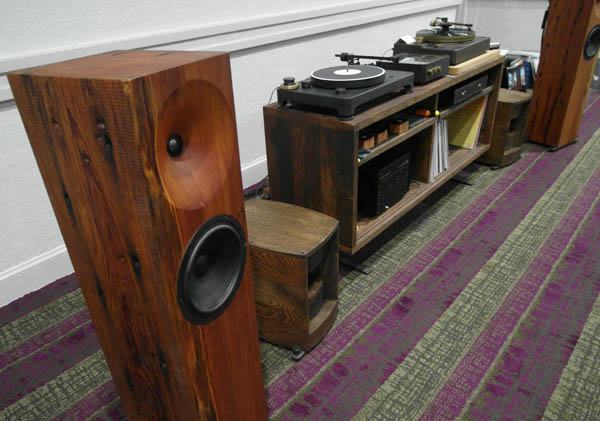
In terms of recreating music's temporal drive and momentum, the system demonstrated by Virginia-based Fern & Roby—a company that's relatively new to perfectionist audio, and that also designs and manufactures high-end furniture—did even better than their system of CAF 2015. Common to both was Fern & Roby's distinctive Tredegar turntable ($8500), seen here on the far right, demonstrated with a Schröder CB tonearm ($5000) and Denon DL103R cartridge ($450). New this year were their Montrose turntable (on the left) with Fern & Roby Uni-Pivot tonearm ($4500 for both). Also in the system were the Fern & Roby Integrated Amplifier ($2500) and their beautifully made The Beam loudspeaker ($6500/pair). With a variety of records—including a live David Bromberg number and an interesting nylon-string-guitar-dominated LP titled Sera una Noche, which seemed ubiquitous at the show—and with the new, less expensive F&R record player doing the honors, the system was rhythmically engaging and very involving overall. There were probably more bobbing heads and tapping feet in the room than at a Linn dealer-training session! (Imagine smiley emoji here.)
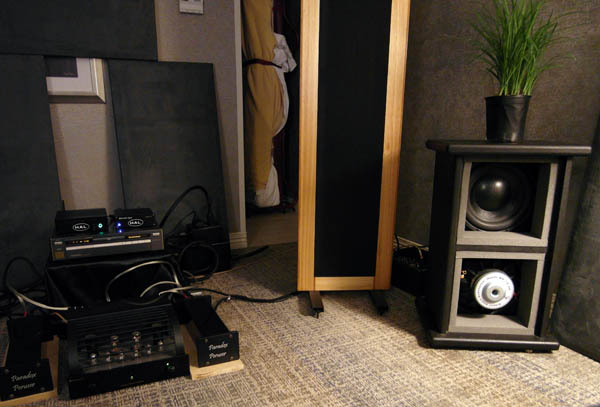
GT Audio Works specializes in loudspeakers that combine planar-magnetic panels—ultra-thin Kapton diaphragms with pure copper signal traces—with ribbon tweeters. At CAF, their GTA3R speakers ($9000/pair, offered at a show special of $7200/pair), supplemented with Sound Insight SI-200 open-baffle powered subwoofers ($6000/pair, with a show special of $4800/pair), did a good job with a high-res file of Miles Davis's "So What," with a nice, rounded tone and decent speed on the string bass, although there was just a shade too much bite on the trumpet. (In fairness I note that, later in the day, someone from GT Audio told me that the system wasn't performing completely up to par during my visit, and invited me to return—although that wasn't possible.) Other components in the system included Paradox Pulse class-A/B solid-state mono power amps ($13,000/pair), a Paradox Pulse USB DAC ($3000), and a Hollis Audio Labs MS-3 server ($799), plus all Paradox cabling.
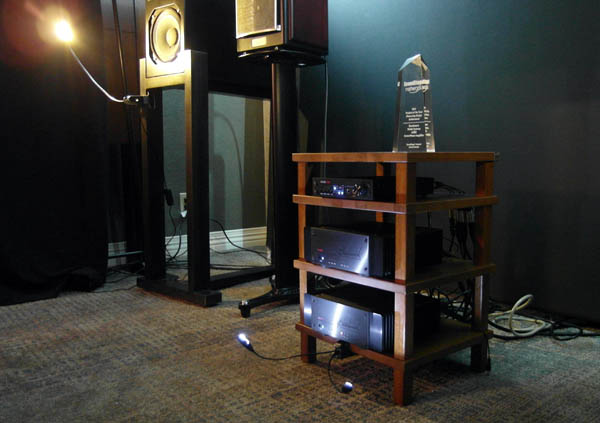
The courage to play banjo music: that's something the lucky showgoer encounters only in those rooms whose sponsors know—really, really know—that their systems won't make a horrid, clattery, barbed-wire-on-glass mess of it. The people representing Benchmark Media Systems electronics and Studio Electric loudspeakers had such confidence, and it was not misplaced: I loved the open, colorful, well-balanced, and immediate sound of this system—and I was happy to have finally heard the Benchmark AHB2 power amp ($2995) that Kal Rubinson and so many others have raved about. Also in the system was the Benchmark DAC2 HGC DAC/preamp ($1995).
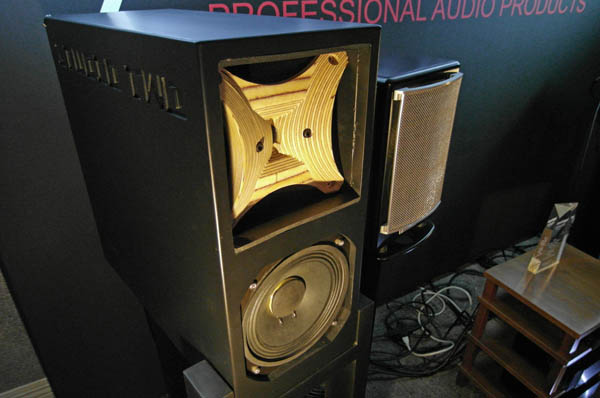
Special mention is due the Studio Two loudspeaker ($7500/pair with stands) from Studio Electric, a company I wasn't familiar with before CAF 2016. This deep-boxed speaker combines an 8" woofer with a 1" compression driver that's loaded with a MacPherson horn. The manufacturer's specs include a 6-ohm impedance and a sensitivity of 93dB. I was very impressed.
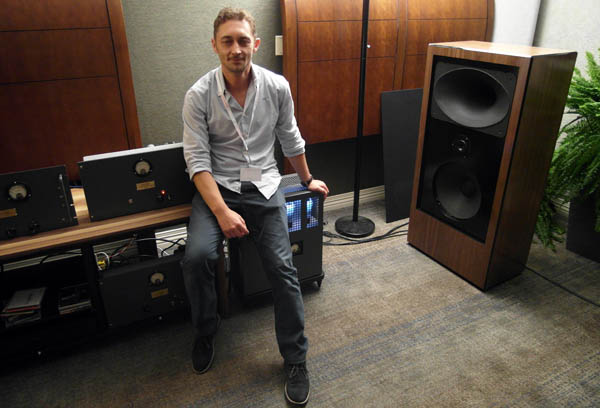
Although the name Aldo D'Urso may not be familiar to many Stereophile readers, those of you with a fondness for vintage gear in general, and classic Western Electric tubes in particular, should check out his work (which can be easily done by visiting his website: www.audioanthology.com). Among his commercial activities is the work Aldo does for the McLean, Virginia audio shop Deja Vu Audio: he builds, in very small quantities, artisanal amps, preamps, and DACs (yes, DACs!) using vintage parts and, for the most part, enclosures reclaimed from far older products (and refinished, of course).
At CAF 2016, Aldo D'Urso was on hand to demonstrate a remarkable mono amplifier (approximately $25,000) he had built using pre-war Western Electric 271A indirectly heated triode tubes in a push-push configuration and pre-war RCA 866 mercury vapor rectifier tubes. Which, as you can see, glow bright blue. Other components in the system included an Aldo D'Urso phono preamplifier ($19,000), and a loudspeaker using a 15" Altec woofer, a 1960s-vintage Japanese ellipsoid horn with compression driver, and a Jensen tweeter ($35,000). The turntable was a mint (a word I do not use lightly; Vu Hoang of Deja Vu later told me it was an NOS item that has been sitting in its original carton for over half a century) grease-bearing hammertone Garrard 301 motor unit with a new Ortofon TA-110 tonearm and Koetsu Rosewood Signature cartridge, the last two being among D'Urso's favorite contemporary products.
The sound? On a selection from the Yamamoto Trio's Midnight Sugar, the playback quality was as impactful, tactile, dramatic, and altogether hypnotic as I have heard.
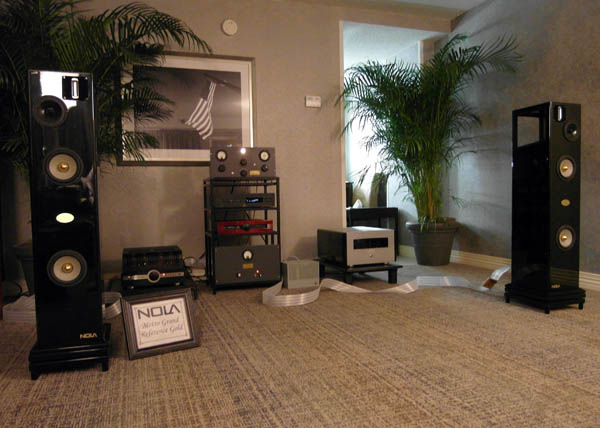
More electronics by Aldo D’Urso—a line-plus-phono preamplifier ($21,000) and a DAC with vintage transformers pressed into service for I/V conversion ($21,000)—were used in Deja Vu Audio's second demonstration room, this one featuring a pair of Nola Metro Grand Reference loudspeakers ($33,000/pair). The 87dB, 8-ohm Nolas use Alnico magnets in all of their drivers except the tweeters, which use neodymium magnets, and they are made in this country and this century. The sound in this room was also superb—open, colorful, and nuanced—albeit with a more modern take on spatial performance and a more neutral, transparent presentation.

What Dudley said, "Doug White, that the man is utterly incapable of making bad sound..."

Just wanted to add that with the Hollis Audio Labs MS-3 Music Server was the Danville Signal Processing, Inc. dspMusik 2x8 DSP multichannel crossover and HiRez DACs. This was being used only as a HiRez DAC for the show as the front end.
The dspMusik can be customized for each installation for the needs of the customers speakers and subs.
Thank you for stopping in for a listen.

Both of Rich's HAL products, MS-3 server, and dspMusik 2x8 DSP multichannel crossover and HiRez DAC, are huge values and undeservedly underreported. These 2 digital pieces played all kinds of music files in this great sounding room and made it easy to find and play fun tunes.

Spent a few very enjoyable hours in their room at CAF2016. Finally heard their Montrose table and Maverick phono pre-amp in my system today. If they set up at a show nearby you have got to hear this table.